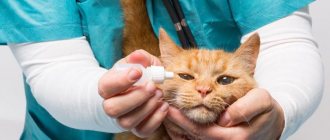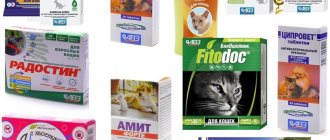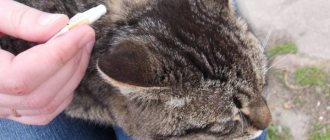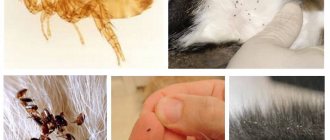Almost every veterinary specialist knows that an animal’s eyes are a “mirror” by which a specialist visually determines whether a cat is sick or not. Today in medicine, many human diseases are diagnosed by the eyes (iridology). Eye diseases in our cats are quite common today. If you do not take the necessary treatment measures in a timely manner, sometimes your pet’s disease can result in loss of vision. Before talking about eye diseases, cat owners should have an idea of what the eye is. A cat's eye is an organ specially adapted for the animal to perceive light waves. With the help of vision, your cat navigates the world around it, perceives the intensity of light, color, shape of objects, distance to them, as well as the movement of objects in space.
Domestic cats are more gentle creatures than their wild relatives. Of course, street cats' eyes fester just as often - this is due to their lifestyle. But when pus appears in the eyes of a pet furbaby, a caring owner will not ignore this alarm signal in any case. Each owner of his pet will strive to figure out why the cat has pus in the eyes, since this is a symptom that the cat is sick with something and will take the necessary measures to eliminate this situation.
Eye drops for cats: indications
The prescriptions for the use of various eye drops in cats are similar, so it is possible to generalize the recommendations for their use.
Anandin for cats
The medicine is prescribed in this form in the following cases:
- infected injuries of the organs of vision (in complex treatment);
- preparing a cat for ophthalmic surgery;
- prevention of complications after eye surgery;
- conjunctivitis of various natures and forms;
- keratitis;
- blepharitis;
- inflammatory processes in the nasolacrimal ducts.
The manifestations of many eye pathologies in cats are similar, which is why trying to self-medicate is quite dangerous. In case of severe lesions, drops are used only in complex therapy in parallel with antibiotic injections.
Treatment of eye suppuration according to the recommendations of a veterinarian
Once the veterinarian determines the cause of the pus discharge from the pet's eyes, he will prescribe the appropriate treatment.
- If the kitten develops swelling, then in this case it is necessary to use a solution of hydrocortisone and novocaine.
- If the pet experiences severe pain, then it is necessary to use a novocaine blockade with an antibiotic. This drug can not only reduce pain, but also relieve the inflammatory process.
- If an animal has an advanced disease, the veterinarian will prescribe a course of antibiotic therapy by injection.
- If pus is released from the eyes after an injury or a foreign object, then the animal must use drops of Levomycetin or Iris.
Any of the above drugs should be used only after consultation with a veterinarian. Self-medication can cause the kitten to lose sight.
Directions for use: how to instill eye drops into a cat
For an animal, the number of instillations per day depends on the prescribed drug, general condition and the instructions of the veterinarian.
The method by which the composition is administered is the same for all types of eye drops. Before instillation, the eyes are washed using a furatsilin solution, a special lotion or saline solution.
A drop of the composition is instilled into each eye of the cat under the lower eyelid.
Ciprovet for cats
A large dosage is not required, as the product will flow out. If the animal responds calmly to treatment, then the bottle can be presented from any side. For cautious pets who are afraid of manipulation, the drops are brought to the eye from the back of the head so that they cannot see anything and become nervous.
When treating an aggressive animal, it is advisable to perform procedures with an assistant. The cat is wrapped in a thick blanket or tucked into the sleeve of a jacket.
While one person is holding the animal, the second is burying it. If the cat categorically does not allow eye drops, you should consult a veterinarian, since there is a high probability that the pet simply cannot tolerate the prescribed drug.
Be sure to read:
Dexafort® instructions for use in veterinary medicine for cats
Prevention
In order to keep your cat’s eyes healthy, it is necessary to follow preventive measures:
- First of all, while walking, you need to avoid injury. If your pet has received minor wounds, it is necessary to treat them as quickly as possible.
- A small kitten needs daily rinsing; for this you can use plain boiled water or a herbal decoction.
- Timely vaccinations will help keep your cat healthy and protect him from infectious diseases and colds.
- Regular use of anthelmintic drugs will help avoid infection with parasites and prevent the occurrence of an allergic reaction to the products of their excretion.
- Scratching wounds located near the eyelids should not be allowed, as this can lead to suppuration of the eye. It is better to trim the hair growing near the organ of vision a little, especially for long-haired breeds.
In other words, this is caring care from the owner, timely preventive vaccinations, and regular medical examinations. If you promptly treat small wounds received while walking, you can avoid health problems, the symptoms of which may be purulent discharge from the eyes.
What eye diseases are common in cats?
The main eye pathologies in cats are:
- Conjunctivitis - when the disease occurs, inflammation of the mucous membrane of the eyelids occurs. The reasons for the development of the disease are varied - from dirt getting into the eye to infection.
- Keratitis is an inflammation of the cornea in cats that usually also affects the eyelids.
- Blepharitis is an inflammation of the eyelids, which may be accompanied by the formation of ulcers.
- Cataracts are similar to this disease in humans and are treated with surgery.
Other pathologies of the visual organs in cats are rarely observed. Injuries to the eyeball more often occur in pets that have free access to the street.
Symptoms of a pet's disease
When a pet gets sick, accompanying symptoms immediately appear. If the owner notices one or more of the following signs of disease in the kitten, he needs to urgently contact a veterinarian.
- The pet has become aggressive and angry, very often rubbing its eyes with its paw:
- The kitten refuses to eat and sleeps poorly;
- In the light, the pet closes its eyes and tries to stay in a dark corner;
- Increased body temperature;
- The eyes water, become red, and purulent formations flow out of them;
- The fur takes on a brownish tint after about a century.
Infectious conjunctivitis
Statistically the leading variant of inflammation of the conjunctiva. Depending on the pathogen, it is divided into subgroups: viral, bacterial, fungal. Moreover, the incidence in children is distributed among these subgroups with approximately equal frequency, while in adults predominantly viral forms are found (over 80%). In the overall structure of morbidity, the proportion of fungal conjunctivitis (ophthalmomycosis) is increasing, which is explained, first of all, by the catastrophically irresponsible and uncontrolled use of antibiotics by the population (when the bacterial flora is suppressed, fungal cultures, including pathogenic ones, are activated).
Drugs for the treatment of viral conjunctivitis
With viral conjunctivitis (it can be caused by influenza viruses, herpes, etc.; in total there are about 40 species dangerous to humans), the main therapeutic goal is to stimulate and intensify the immune response. For this purpose the following are appointed:
- eye drops based on human interferon (Ophthalmoferon, Interferon, etc.);
- drugs that stimulate the production of endogenous, own interferon (Poludan, Tsitovir, Cycloferon);
- eye ointments (Bonafton, Acyclovir, Florenal, etc.);
- according to indications - vasoconstrictor and/or moisturizing drugs (“artificial tears”), similar to Vizin, Oksial, etc.
Drops and ointments for bacterial (purulent) form
For bacterial conjunctivitis, antibiotics are prescribed:
- drops (Albucid, Levomitin, Tsipromed, etc.);
- eye ointments (tetracycline, erythromycin, gentamicin, ofloxacin);
- tablet drugs (Doxycycline, Sumamed, Vilprafen, etc.; for chlamydia, Levofloxacin, Lomefloxacin).
Only a specialist can prescribe medications (and their dosage, frequency and duration of use) and evaluate the effectiveness of their use! By contacting our ophthalmology center, you can be sure of an individual approach and high results in the treatment of eye diseases in children and adults.
Treatment of fungal infections (mycoses)
For fungal conjunctivitis (ophthalmomycosis), treatment, as a rule, lasts much longer than for other infectious conjunctivitis, and includes specific antimycotic agents, and antifungal eye drops are practically not produced on an industrial scale in the world - they are prepared extemporaneously (as needed): Fluconazole , Amphotericin et al.
Some cases require additional intake of tablet forms of the antimycotic, as well as the simultaneous use of anti-inflammatory, antihistamine (antiallergic) and antibacterial drops and ointments.
Fig. 3 Eye drops are placed behind the eyelid at night and provide long-lasting effects
Red eyes after eyelash extensions
Red eyes after eyelash extensions
The application of artificial eyelashes is a complex process involving the use of chemicals in close proximity to the human eye.
Violation of technology, use of low-quality materials and failure to comply with aseptic conditions in the cosmetology department often causes redness of the eyes after eye extensions. What drops can help?
Red eyes after eyelash extensions occur for several reasons: 1. Toxic effect of eyelash glue on the conjunctiva 2. Foreign body (glue) in the conjunctival cavity 3. Infection in the conjunctiva of the eye 4 Allergic reaction
1. Toxic effect of eyelash glue on the conjunctiva
Artificial eyelashes glued to existing ones using glue.
The most commonly used are latex, rubber adhesive, rubber adhesive and resins. They all differ in their toxic effects on the mucous membrane of the eye and in the time of exposure due to different drying rates. You need to understand that any product, even the most high-quality and expensive, has a toxic effect on the mucous membrane of the eyelid upon contact. A toxic burn occurs and, as a result, vasodilation and red eyes. The occurrence of redness in this case directly depends on the literacy of the specialist and the quality of the glue used. In case of redness of the eyes for this reason, it is necessary to rinse the eyes well with warm water to completely remove the glue from the conjunctival cavity. Drugs containing the hormonal corticosteroid component will help stop the process of toxic inflammation. These include drops such as Dexamethasone, Tobradex, Maxidex
; for the simultaneous prevention of secondary infection, you can use
Tobrex, Maxitrol
.
To heal damaged areas of the eye, you can use eye ointments and drops: Solcoseryl, Citral, Korneregel
.
To quickly narrow blood vessels and eliminate redness of the eyes, you can use Visine
.
2. Foreign body (glue) in the conjunctival cavity
If glue gets into the conjunctival cavity and hardens there, a foreign body is formed that constantly injures the mucous membrane, causing inflammation and redness of the eye.
In this case, the red eye also hurts. My eyes are watering. In this case, it is necessary to remove it by washing with warm water; if this does not work, you must contact an ophthalmologist to remove the foreign body using microsurgical instruments under a microscope. 3. Infection in the conjunctiva
A violation of technology or an infected film used on the inside of the eyelid for eyelash extensions can cause an inflammatory process of the eyes with redness and often accompanied by discharge of varying consistency and transparency.
In most cases, the cause of redness is a bacterial infection. Treatment should be carried out using antibacterial agents, such as drops such as Tobrex, Tobradex, Maxitrol, Levomycetin, Albucid (Sodium Sulfacyl) 20%, Levofloxacin, Oftalmoferon, Vitabact.
Instillation of drops is recommended 1 drop 4 times a day for a week.
As an ointment, you can use T etracycline ointment
, which has a wide range of effects on bacteria. You need to apply the ointment behind your eyelids twice a day, morning and evening. It must be borne in mind that the base of any ointment is often an allergen and a possible source of bacterial activity. Therefore, we recommend the use of anti-inflammatory drugs in drops.
4. Allergic reaction
Allergic redness of the eyes after eyelash extensions is also a common cause of redness.
The base of any glue used for gluing artificial eyelashes is an allergen and, with increased individual sensitivity of the body, can cause an allergic reaction with redness of the eyes, accompanied, as a rule, by swelling of the eyelids of varying degrees. For the appearance of allergic redness of the eyes, simply evaporation of the glue is sufficient, the complete hardening of which occurs from several hours to three days. Redness can be eliminated by reducing the body's reaction through the general use of antiallergic antihistamines, such as Suprastin, Tavegil, Cytarizine, Ebastine
.
The following will help reduce redness of the eyes during an allergic reaction: Dexamethasone
,
Tobradex
,
Maxidex,
1 drop 3 times a day for 2-3 days.
Or Hydrocortisone ointment
(twice a day, morning and evening), which contains a corticosteroid hormone that suppresses the body’s inflammatory and allergic reaction.
How to distinguish chemical burns from allergies after eyelash extensions?
You can distinguish a chemical burn from an allergy by the condition of the conjunctiva and swelling of the eyelids. Doing this at home is quite problematic, since the clinical picture will also depend on the degree of the burn. With a chemical burn, the conjunctiva loses its transparency and shine. Its surface becomes dull, and in some places there may be gray films that are easily removed. In an allergic reaction, the conjunctiva is much more swollen, its folds are visible, but at the same time it retains its shine. Detachable, no films. An allergic reaction, including after eyelash extensions, is usually bilateral. The eyelids of both eyes are swollen. While a chemical burn most often occurs on one eye. The eyelids may also be swollen, but to a lesser extent than with allergies. To avoid mistakes, it is enough to visit an ophthalmologist and perform a biomicroscopy
eyes, in which an accurate diagnosis will be made.
To find out the exact cause of eye redness after eyelash extensions and choose pathogenetic targeted treatment, we recommend that you consult with an ophthalmologist and choose the right treatment.











